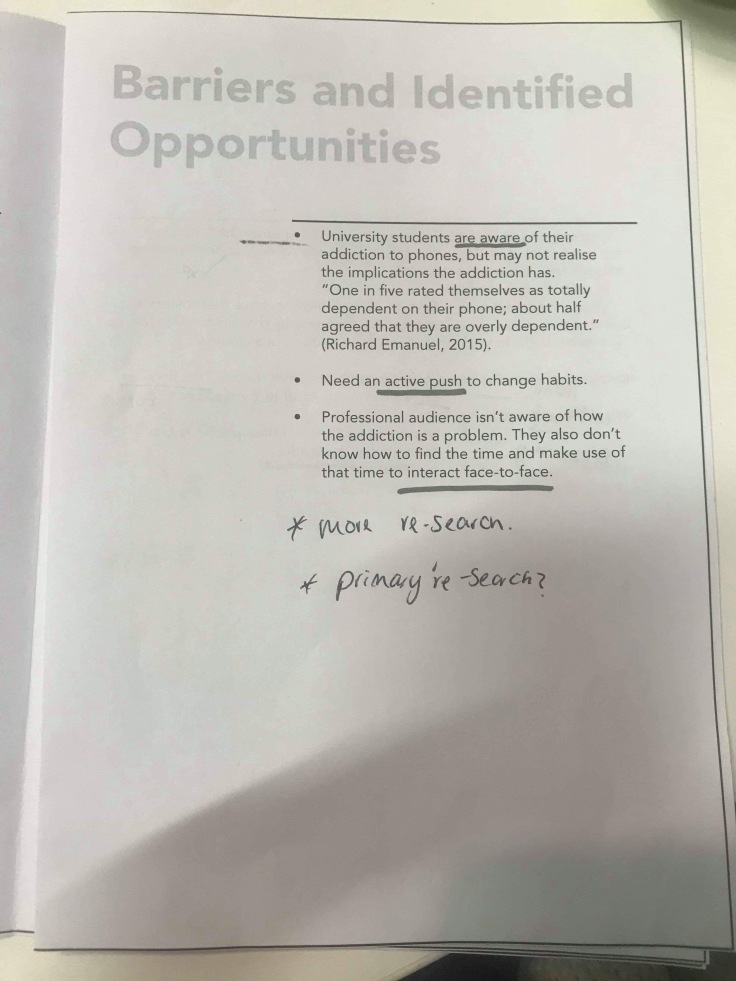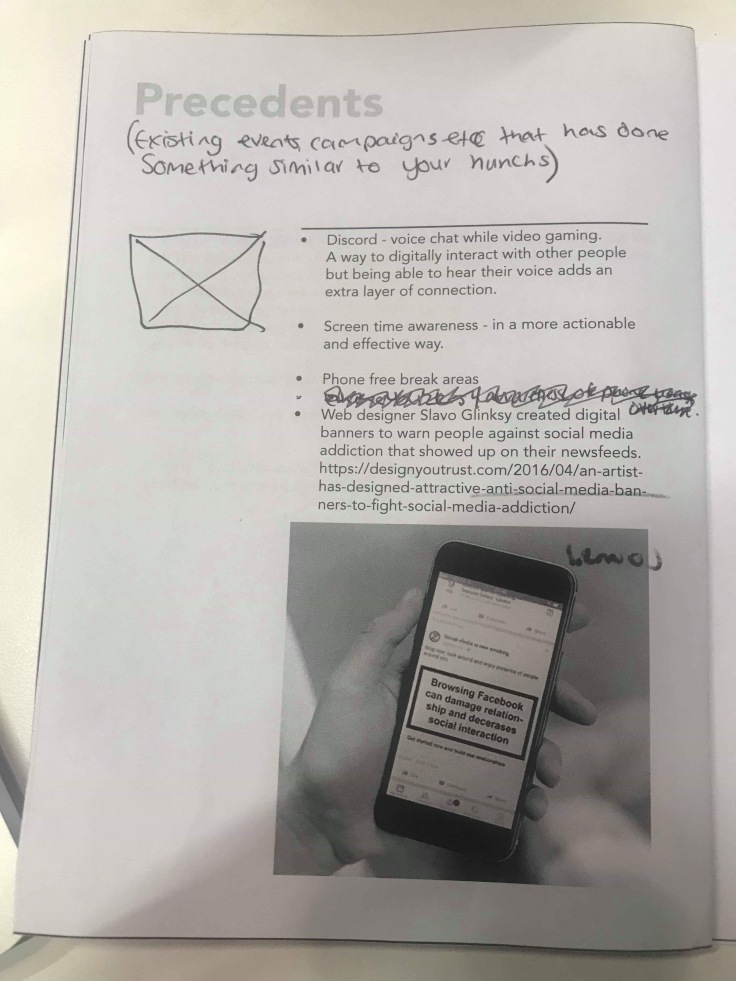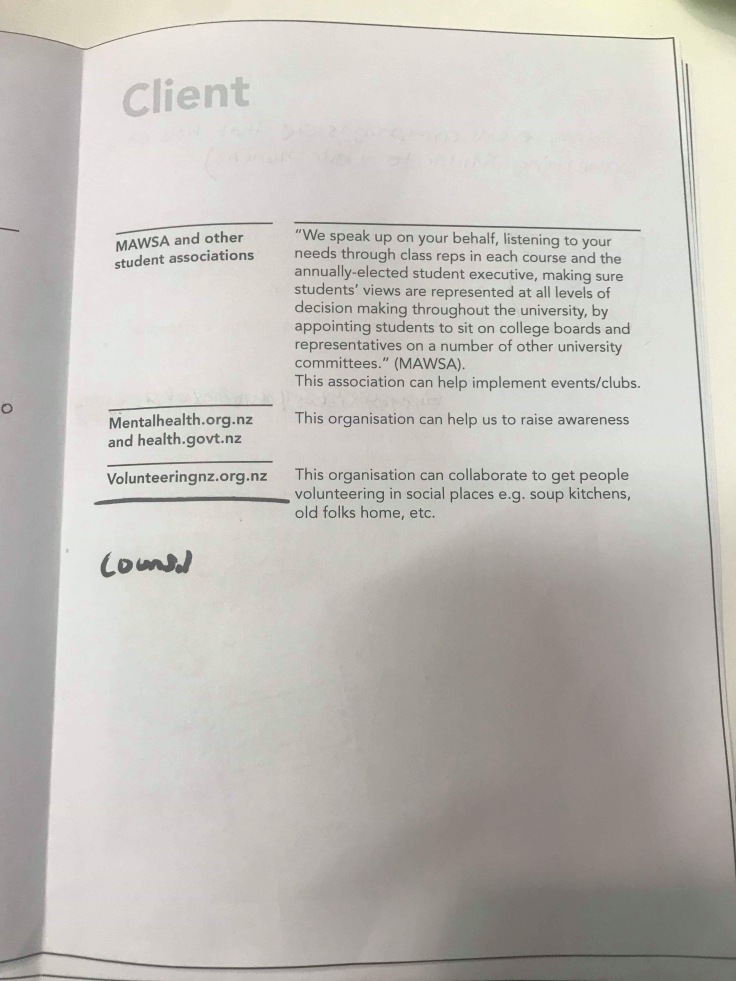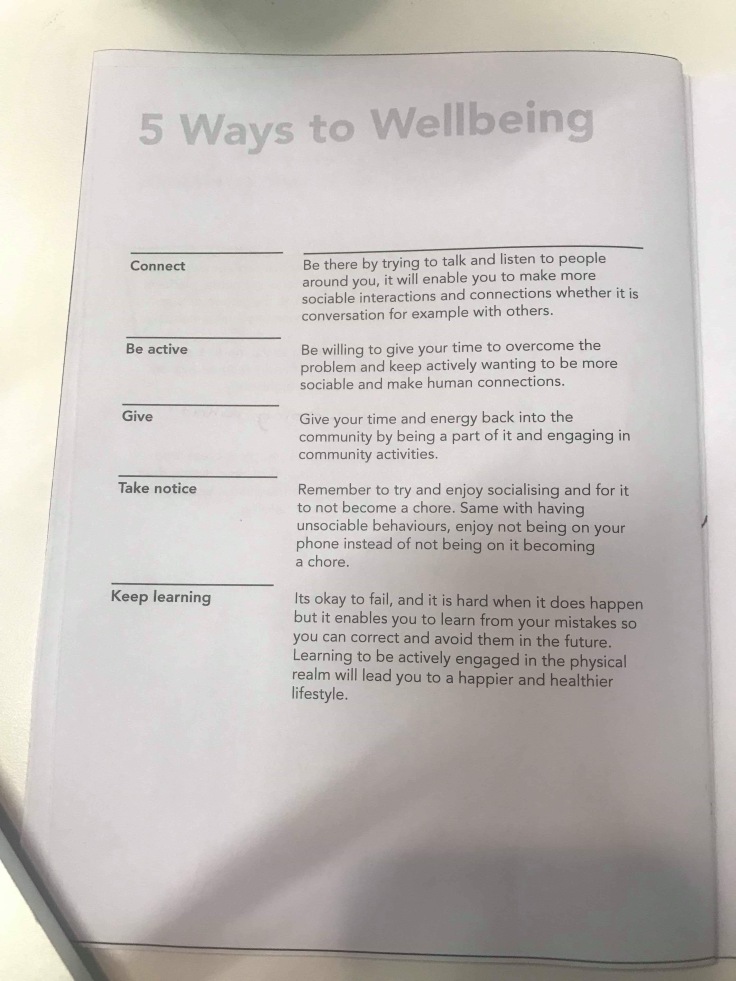Draft Proposal printout + Critique










Critique: To summaries, the critique, the main element which we felt impacted us the most, was the fact that we needed to change our focus more as we were too wide in what we were trying to cover and not really specialising in an area.
From this, we decided to focus more on Smart Phone addiction instead of unsociable behaviour and loneliness.
REWRITE + REDESIGN:
Brief Round 2 – focused solely on smartphone addiction
Audience
PERSON 1: (focusing on mainly one audience instead of having 2.)
DEMOGRAPHICS:
- University Student
- Lives in an urban area
- 18-25
PSYCHOGRAPHICS:
- Stressed and anxious from university workload
- Sleep-deprived
Kevin is a 20 year old male university student. He is anxious due to a heavy workload and stays up late at night. He tends to keep his phone with him at all times.
Existing Situation
Key issue:
Smartphone addiction in students is increasing rapidly. Because of this, many of them are generally spending more time looking at screens rather than physically socialising.
Related issues:
Increase in mental health issues
– Higher levels of social anxiety
– Depression
– Loneliness
– Lack of ability to focus
A more isolated society
– Where people don’t talk to each other in person
– Lack of proper social skills
Loss of interest in physical activities
Kevin brings his phone with him everywhere and uses it very frequently, even if he doesn’t need to. Because of this, he lacks the motivation to utilise his social time well and doesn’t see many people in person.
Primary Research
- 85.7% of those surveyed by us consider themselves to use their phones too much.
- A third of New Zealand teens (33%) spend 4 or more hours online in an average day.
- 4 in 10 currently use 5 or more social media platforms.
Digital technologies are an important part of New Zealand teens’ everyday lives. While they use a range of digital devices to connect (e.g., desktop computer, game console or smart TV) they report largely using smartphones and laptop computers to go online. This finding shows the preference of New Zealand teens for mobile digital tools.
We asked survey participants about the number of digital devices they typically use to connect online. A majority (59%) of teens said they use three or more devices, while the rest (41%) connect online through one or two devices.
The average daily time spent online by a third of teens (33%) is 4 or more hours, nearly 4 in 10 (38%) are online for between 2 and 4 hours, and 20% for 1 to 2 hours. The remaining responses (9%) either spend 1 hour or less or were unsure about how much time they were online for.
A survey done by Deloitte in 2017 found that two fifths (38 percent) of those surveyed believe that they are using their phone too much. In the 16-24 age group, 56 percent said they are using too much,
- “Compulsive use of the Internet and smartphone apps can cause you to neglect other aspects of your life, from real-world relationships to hobbies and social pursuits” (Melinda Smith, M.A., Lawrence Robinson, and Jeanne Segal, Ph.D. Last updated, 2019).
- there’s a rise in cell phone usage in NZ (Stats NZ, 2017)
- https://www.cnet.com/news/cutting-your-screen-time-isnt-curbing-your-phone-addiction-survey-says/
Thirty-one percent of people are concerned tech has negatively affected our ability to connect with each other, according to Mojo Vision’s survey.
Desired Situation/Outcomes/Action
There needs to be a way to generate the motivation to change phone habits and make people care about their phone addiction. This could be done through creating an awareness around the negative impact that smartphones addiction has on our social lives.There needs to be a push on promoting social interactions in person rather than on social media.
Generate ways to motivate the audience into changing their phone habits.
Potentially adding a time limit on how long they use certain apps like social media.
Cutting down on social media in general (Uninstalling the apps, deleting the account)
Create an awareness of the negative impact smartphone addiction has on our social lives.
Find out ways/methods to make people care more about the overuse of smartphones
Promote social interactions in person rather than through social media.
Give Kevin the awareness he needs to change his phone habits, and give him a safe environment where he feels comfortable socialising without his phone.
Barriers and Identified Opportunities
Through our primary research, we asked people who answered ‘yes’ to answering their phone too much, how they limit their phone usage. We were surprised when half of the answers were that they don’t try at all.
Some other answers involved keeping their phone in a separate area and/or turning it on silent or off
There are already initiatives implemented to help on smartphones such as screen-time blocker, but they aren’t that effective according to our survey.
People know that they’re addicted to their phones but don’t care enough or have a good enough reason to change their habits.
Kevin doesn’t have the sufficient motivation and information to provoke action.
- Through our primary research many students showed an interest in reading in a situation where they didn’t have a phone.
- 1 in 4 would be devastated if they had no access to digital technologies for a Month.
We wanted to know the level of participants’ affinity with digital technologies. Interestingly, one in four (25%) responded they would be “devastated” if they could not use any digital technology for a month, 30% of respondents mentioned they would miss digital technologies “quite a lot”, and 34% would feel “annoyed but get used to it”.
- “One in five rated themselves as totally dependent on their phone; about half agreed that they are overly dependent.” (Richard Emanuel, 2015).
All participants in our survey responded saying they believed that phones can be addicting.
How Might We?
How might we create motivation in the target audience to put down their smartphones?
How might we inform the audience of their phone habits and the negative implications on physical socialising skills?
How might we create phone free atmospheres within break times throughout offices?
How might we create a space where people feel safe to not be on their phones?
Precedents
Boxes where you lock your phones in
Distractagone is a product where you can lock your phone away for a certain period of time to help you focus or engage with your surroundings.
“Many of us are addicted to our smartphone. Although we often acknowledge the problem, we don’t seem to act. Can’t we just put away our phones when we have to work, study, go to a restaurant, watch a movie, have a coffee, read a book, watch a game or have family time? We wish it was easy, but there’s always an excuse. Let’s face it: we all get too distracted. DistractaGone offers a simple solution for you and for those around you. Find some peace and focus with DistractaGone.”
Screen time apps
This app is designed to monitor your screen time on smartphones and also connecting you with real life interests to encourage you to get out and do other things. You can add goals and everything.
https://play.google.com/store/apps/details?id=com.systweak.social_fever&hl=en_US
Social media awareness banners
- Slavo Glinsky created digital banners to warn people against social media addiction that showed up on their newsfeeds.
Boardgame cafes
Counter Culture Cafe in Wellington is a cafe where people can put their phones down and socialise over food and board games.
Massey Makery
Creative DIY sessions, such as beeswax wraps, weaving, language skills etc, aimed at learning new practical skills, building community and making friends, and then being able to pass this knowledge onto the wider massey community. May also be a focus on sustainability and mindfulness when producing these new products.
Hunches
What can we do to distract ourselves from our phones?
Phone free areas, such as office spaces, cafes or hubs.
Social event that gets people to put away their phones and connect with likeminded people
Swap your phone for an animal initiative – could help looking after spca pets
Phone usage awareness alerts – could include suggestions of what to do instead of using phone.
Analog cafes where you can write notes or draw or read, but you can’t use your phone.
Rely on smartphone addiction.
Volunteering
5 Ways to wellbeing
Where is the potential or natural synergy? Don’t shoe-horn this in. Based on your research where do you think the potential or natural synergy is and why.
- Embrace new experiences and opportunities.
- Be willing to give your time to overcome the problem.
- Keeping actively wanting to be more sociable.
- It’s okay to fail, and it is hard when it does happen but it enables you to learn from your mistakes so you can correct and avoid them in the future.
- Be there, by trying to talk and listen to people around you it will enable you to make more sociable interaction whether it is a conversation for example with others.
- Take notice of the amount of time you’re spending on your phone.
- Learning to be actively engaged in the physical realm will lead you to a happier and healthier lifestyle.
—– KEY ELEMENT ——
We really like using the ‘Kevin’ personae to show an audience’s perspective in the information and how it relates.
See full document of testing different pages above.










Leave a comment